Techno-Economic Analysis of Marine Hybrid Clusters for Use in Chile and Mexico
Abstract
1. Introduction
2. Materials and Methods
3. Results
4. Discussion
4.1. Site-Specific Wave Energy Resource Availability and Power Production of WECs and OWT
4.2. Electricity Generation of Hybrid MRE Systems and Consumption by the Analyzed Scenarios
4.3. Energy Storage Solutions
4.4. MHC Profitability and Blue Economy Opportunities
5. Conclusions
Author Contributions
Funding
Institutional Review Board Statement
Informed Consent Statement
Data Availability Statement
Acknowledgments
Conflicts of Interest
Abbreviations
| ACDPs | Acoustic Doppler Current Profilers |
| AEP | Annual energy production |
| BES | Battery energy storage |
| CapEx | Capital Expenditures |
| ENSO | El Niño-Southern Oscillation |
| ERA5 | European Centre for Medium-Range Weather Forecasts Reanalysis v5 |
| HES | Hydrogen energy storage |
| HP | Harvested wave power |
| HR | Availability matrix |
| INEGI | Instituto Nacional de Estadística y Geografía |
| IOWAGA | Integrated Ocean Waves for Geophysical and other applications model |
| IRR | Internal Rate of Return |
| LCoE | Levelized cost of energy |
| LSB | La Serena Bay |
| MHCs | Maritime hybrid clusters |
| MRE | Marine renewable energies |
| MWh | MegaWatt-hour |
| NREL | National Renewable Energy Laboratory |
| NPV | Net present value |
| OpEx | Operational Expenditures |
| OWTs | Offshore wind turbines |
| PAN | Panul |
| PEL | Pelamis device |
| PST | Punta Santo Tomas |
| RE | Renewable energy |
| SWAN | Simulating WAves Nearshore model |
| TSB | Todos Santos Bay |
| TSI | Todos Santos Islands |
| USD | United States Dollar |
| WD | Wave Dragon device |
| WEC | Wave energy converter |
References
- McCarthy, J.J. Climate Change 2001: Impacts, Adaptation, and Vulnerability: Contribution of Working Group II to the Third Assessment Report of the Intergovernmental Panel on Climate Change; Cambridge University Press: Cambridge, UK, 2001; Volume 2, Available online: https://www.ipcc.ch/site/assets/uploads/2018/03/WGII_TAR_full_report-2.pdf (accessed on 20 June 2024).
- International Energy Agency. World Energy Outlook 2023. 2023. Available online: https://www.iea.org/reports/world-energy-outlook-2023 (accessed on 21 June 2024).
- International Renewable Energy Agency. Renewable Power Generation Costs in 2021. 2022. Available online: http://large.stanford.edu/courses/2022/ph240/cruz2/docs/irena-2021.pdf (accessed on 23 June 2024).
- Rogelj, J.; Den Elzen, M.; Höhne, N.; Fransen, T.; Fekete, H.; Winkler, H.; Schaeffer, R.; Sha, F.; Riahi, K.; Meinshausen, M. Paris Agreement climate proposals need a boost to keep warming well below 2 C. Nature 2016, 534, 631–639. [Google Scholar] [CrossRef]
- Bahaj, A.S. Generating Electricity from the Oceans. Renew. Sustain. Energy Rev. 2011, 15, 3399–3416. [Google Scholar] [CrossRef]
- Global Wind Energy Council. Global Offshore Wind Report 2024. 2024. Available online: https://www.connaissancedesenergies.org/sites/connaissancedesenergies.org/files/pdf-actualites/GOWR-2024_digital_final_2.pdf (accessed on 21 July 2024).
- Costoya, X.; DeCastro, M.; Carvalho, D.; Gómez-Gesteira, M. On the Suitability of Offshore Wind Energy Resource in the United States of America for the 21st Century. Appl. Energy 2020, 262, 114537. [Google Scholar] [CrossRef]
- Shadman, M.; Roldan-Carvajal, M.; Pierart, F.G.; Haim, P.A.; Alonso, R.; Silva, C.; Osorio, A.F.; Almonacid, N.; Carreras, G.; Maali-Amiri, M.; et al. A Review of Offshore Renewable Energy in South America: Current Status and Future Perspectives. Sustainability 2023, 15, 1740. [Google Scholar] [CrossRef]
- Hernández-Fontes, J.V.; Felix, A.; Mendoza, E.; Cueto, Y.R.; Silva, R. On the Marine Energy Resources of Mexico. J. Mar. Sci. Eng. 2019, 7, 191. [Google Scholar] [CrossRef]
- Gunn, K.; Stock-Williams, C. Quantifying the Global Wave Power Resource. Renew. Energy 2012, 44, 296–304. [Google Scholar] [CrossRef]
- Gorr-Pozzi, E.; García-Nava, H.; Larrañaga, M.; Jaramillo-Torres, M.G.; Verduzco-Zapata, M.G. Wave Energy Resource Harnessing Assessment in a Subtropical Coastal Region of the Pacific. J. Mar. Sci. Eng. 2021, 9, 1264. [Google Scholar] [CrossRef]
- Ocean Energy Europe. Ocean Energy Key Trends and Statistics 2022. 2023. Available online: https://www.oceanenergy-europe.eu/wp-content/uploads/2023/03/Ocean-Energy-Key-Trends-and-Statistics-2022.pdf (accessed on 11 July 2024).
- IEA-OES. Annual Report: An Overview of Ocean Energy Activities in 2023. 2024. Available online: https://www.ocean-energy-systems.org/publications/oes-annual-reports/document/oes-annual-report-2024/ (accessed on 12 March 2025).
- Astariz, S.; Iglesias, G. The Economics of Wave Energy: A Review. Renew. Sustain. Energy Rev. 2015, 45, 397–408. [Google Scholar] [CrossRef]
- The Executive Committee of IEA Ocean Energy Systems. Annual Report: An Overview of Ocean Energy Activities in 2021. 2022. Available online: https://www.ocean-energy-systems.org/publications/oes-annual-reports/document/oes-annual-report-2021/ (accessed on 10 June 2024).
- Giglio, E.; Petracca, E.; Paduano, B.; Moscoloni, C.; Giorgi, G.; Sirigu, S.A. Estimating the Cost of Wave Energy Converters at an Early Design Stage: A Bottom-Up Approach. Sustainability 2023, 15, 6756. [Google Scholar] [CrossRef]
- Corrales-Gonzalez, M.; Lavidas, G.; Lira-Loarca, A.; Besio, G. Wave Energy Assessment and Wave Converter Applicability at the Pacific Coast of Central America. Front. Energy Res. 2024, 12, 1454275. [Google Scholar] [CrossRef]
- Meneses, E.; Soria, R.; Portilla, J.; Guachamín-Acero, W.; Álvarez, R.; Paredes, R.; Arias-Hidalgo, M. The Potential of Wave Energy Converters in the Galapagos Islands. Energy Strategy Rev. 2024, 54, 101457. [Google Scholar] [CrossRef]
- Sánchez, A.; Mendoza, E. Wave energy converter farm feasibility assessment in southwest Baja California, Mexico. Renew. Energy 2024, 227, 120589. [Google Scholar] [CrossRef]
- Selman-Caro, D.; Gorr-Pozzi, E.; Odériz, I.; Díaz-Hernández, G.; García-Nava, H.; Silva, R. Assessing wave energy for possible WEC installations at La Serena, central Chile. Ocean Eng. 2024, 295, 116854. [Google Scholar] [CrossRef]
- Gorr-Pozzi, E.; Olmedo-González, J.; Selman-Caro, D.; García-Nava, H.; García-Vega, F.; Odériz, I.; González-Huerta, R.G.; Zertuche-González, J.A.; Silva, R. Techno-economic analysis of marine hybrid clusters in two potential Latin American markets. In Proceedings of the 15th European Wave and Tidal Energy Conference, Bilbao, Spain, 3–7 September 2023. [Google Scholar] [CrossRef]
- Clemente, D.; Rosa-santos, P.; Taveira-pinto, F. On the Potential Synergies and Applications of Wave Energy Converters: A Review. Renew. Sustain. Energy Rev. 2021, 135, 110162. [Google Scholar] [CrossRef]
- Tobal-Cupul, J.G.; Garduño-Ruiz, E.P.; Gorr-Pozzi, E.; Olmedo-González, J.; Martínez, E.D.; Rosales, A.; Navarro-Moreno, D.D.; Benítez-Gallardo, J.E.; García-Vega, F.; Wang, M.; et al. An Assessment of the Financial Feasibility of an OTEC Ecopark: A Case Study at Cozumel Island. Sustainability 2022, 14, 4654. [Google Scholar] [CrossRef]
- Gorr-Pozzi, E.; Olmedo-González, J.; Silva, R. Deployment of Sustainable Off-Grid Marine Renewable Energy Systems in Mexico. Front. Energy Res. 2022, 10, 1047167. [Google Scholar] [CrossRef]
- Hemmati, R.; Saboori, H. Emergence of Hybrid Energy Storage Systems in Renewable Energy and Transport Applications—A Review. Renew. Sustain. Energy Rev. 2016, 65, 11–23. [Google Scholar] [CrossRef]
- Fletcher, Z.J. Aquaculture in Multiple Use of Space for Island Clean Autonomy. In WCFS2020; Piątek, Ł., Lim, S.H., Wang, C.M., de Graaf-van Dinther, R., Eds.; Springer: Singapore, 2022. [Google Scholar]
- Ahmed, M.; Lorica, M.H. Improving Developing Country Food Security through Aquaculture Development—Lessons from Asia. Food Policy 2002, 27, 125–141. [Google Scholar] [CrossRef]
- Grand View Research. Commercial Seaweed Market Analysis by Product (Brown Seaweed, Red Seaweed, Green Seaweed), by Form (Liquid, Powdered, Flakes), by Application (Agriculture, Animal Feed, Human Consumption) and Segment Forecasts to 2024. 2024. Available online: https://www.industryarc.com/Research/Commercial-Seaweeds-Market-Research-504442 (accessed on 14 March 2025).
- Pellow, M.A.; Emmott, C.J.M.; Barnhart, C.J.; Benson, S.M. Hydrogen or Batteries for Grid Storage? A Net Energy Analysis. Energy Environ. Sci. 2015, 8, 1938–1952. [Google Scholar] [CrossRef]
- Gorr-Pozzi, E.; García-Nava, H.; García-Vega, F.; Zertuche-González, J.A. Techno-Economic Feasibility of Marine Eco-Parks Driven by Wave Energy: A Case Study at the Coastal Arid Region of Mexico. Energy Sustain. Dev. 2023, 76, 101299. [Google Scholar] [CrossRef]
- Zimmermann, T.; Keil, P.; Hofmann, M.; Horsche, M.F.; Pichlmaier, S.; Jossen, A. Review of System Topologies for Hybrid Electrical Energy Storage Systems. J. Energy Storage 2016, 8, 78–90. [Google Scholar] [CrossRef]
- Bartolucci, L.; Cordiner, S.; Mulone, V.; Rocco, V.; Rossi, J.L. Hybrid Renewable Energy Systems for Renewable Integration in Microgrids: Influence of Sizing on Performance. Energy 2018, 152, 744–758. [Google Scholar] [CrossRef]
- Naderipour, A.; Abdul-Malek, Z.; Nowdeh, S.A.; Kamyab, H.; Ramtin, A.R.; Shahrokhi, S.; Klemeš, J.J. Comparative Evaluation of Hybrid Photovoltaic, Wind, Tidal and Fuel Cell Clean System Design for Different Regions with Remote Application Considering Cost. J. Clean. Prod. 2021, 283, 124207. [Google Scholar] [CrossRef]
- Petracca, E.; Faraggiana, E.; Ghigo, A.; Sirigu, M.; Bracco, G.; Mattiazzo, G. Design and Techno-Economic Analysis of a Novel Hybrid Offshore Wind and Wave Energy System. Energies 2022, 15, 2739. [Google Scholar] [CrossRef]
- Coles, D.; Angeloudis, A.; Goss, Z.; Miles, J. Tidal Stream vs. Wind Energy: The Value of Cyclic Power When Combined with Short-Term Storage in Hybrid Systems. Energies 2021, 14, 1106. [Google Scholar] [CrossRef]
- Bocklisch, T. Hybrid Energy Storage Systems for Renewable Energy Applications. Energy Procedia 2015, 73, 103–111. [Google Scholar] [CrossRef]
- Sánchez-Dirzo, R.; González-Huerta, R.G.; Mendoza, E.; Silva, R.; Sandoval Pineda, J.M. From Wave to Jet and from Jet to Hydrogen: A Promising Hybrid System. Int. J. Hydrogen Energy 2014, 39, 16628–16636. [Google Scholar] [CrossRef]
- Ocean Energy Systems. Wave Energy Developments Highlights 2023. 2023. Available online: https://www.ocean-energy-systems.org/publications/oes-brochures/document/wave-energy-developments-highlights-2023/ (accessed on 23 July 2024).
- Instituto Nacional de Estadística y Geografía (INEGI). Anuario Estadístico y Geográfico de Baja California 2017. 2017. Available online: https://www.inegi.org.mx/contenido/productos/prod_serv/contenidos/espanol/bvinegi/productos/nueva_estruc/anuarios_2017/702825094874.pdf (accessed on 24 July 2024).
- Energía Región. Energía Región de Coquimbo. 2023. Available online: https://energiaregion.cl/region/COQ (accessed on 26 July 2024).
- Energía Alternativa. Energía Alternativa Estudio Técnico de Las Fuentes de Energía Alterna Disponibles Para Su Implementación En La Planta de Producción de Alga Ulva Sp. de Productos Marinos de Las Californias S. de R.L. de C.V. 2020. Available online: https://blueevolution.com/category/blog/press-release/ (accessed on 26 June 2024).
- SWAN Team. SWAN Cycle III Version 40.51 User Manual; Delft University of Technology, Faculty of Civil Engineering and Geosciences, Environmental Fluid Mechanics Section: Delft, The Netherlands, 2006; Available online: https://falk.ucsd.edu/modeling/swanuse.pdf (accessed on 21 April 2024).
- Janssen, P. The Interaction of Ocean Waves and Wind; Cambridge University Press: Cambridge, UK, 2004. [Google Scholar]
- Selman-Caro, D.A. Cuantificación del Recurso EnergéTico Undimotriz en Diferentes Escales de Tiempo en la Serena, Chile. Ph.D. Thesis, Universidad Nacional Autónoma de México, Mexico City, Mexico, 2023. Available online: https://repositorio.unam.mx/contenidos/cuantificacion-del-recurso-energetico-undimotriz-en-diferentes-escalas-de-tiempo-en-la-serena-chile-3698632?c=%7B (accessed on 12 July 2024).
- Lavidas, G.; Venugopal, V. A 35 Year High-Resolution Wave Atlas for Nearshore Energy Production and Economics at the Aegean Sea. Renew. Energy 2017, 103, 401–417. [Google Scholar] [CrossRef]
- Hersbach, H.; Bell, B.; Berrisford, P.; Hirahara, S.; Horányi, A.; Muñoz-Sabater, J.; Nicolas, J.; Peubey, C.; Radu, R.; Schepers, D.; et al. The ERA5 Global Reanalysis. Q. J. R. Meteorol. Soc. 2020, 146, 1999–2049. [Google Scholar] [CrossRef]
- Shu, Z.R.; Li, Q.S.; Chan, P.W. Statistical Analysis of Wind Characteristics and Wind Energy Potential in Hong Kong. Energy Convers. Manag. 2015, 101, 644–657. [Google Scholar] [CrossRef]
- Vega, L.; Michaelis, D. First Generation 50 MW OTEC Plantship for the Production of Electricity and Desalinated Water. In Proceedings of the Annual Offshore Technology Conference, Houston, TX, USA, 3–6 May 2010; pp. 2979–2995. [Google Scholar] [CrossRef]
- de Andres, A.; MacGillivray, A.; Guanche, R.; Jeffrey, H. Factors Affecting LCOE of Ocean Energy Technologies: A Study of Technology and Deployment Attractiveness. In Proceedings of the 5th International Conference on Ocean Energy, Halifax, NS, Canada, 4–6 November 2014; pp. 1–11. Available online: https://tethys-engineering.pnnl.gov/sites/default/files/publications/andresetal.pdf (accessed on 12 April 2024).
- Lavidas, G.; Blok, K. Shifting Wave Energy Perceptions: The Case for Wave Energy Converter (WEC) Feasibility at Milder Resources. Renew. Energy 2021, 170, 1143–1155. [Google Scholar] [CrossRef]
- Dalton, G.J.; Alcorn, R.; Lewis, T. Case Study Feasibility Analysis of the Pelamis Wave Energy Convertor in Ireland, Portugal and North America. Renew. Energy 2010, 35, 443–455. [Google Scholar] [CrossRef]
- Allan, G.; Gilmartin, M.; McGregor, P.; Swales, K. Levelised Costs of Wave and Tidal Energy in the UK: Cost Competitiveness and the Importance of “Banded” Renewables Obligation Certificates. Energy Policy 2011, 39, 23–39. [Google Scholar] [CrossRef]
- Dalton, G.J.; Alcorn, R.; Lewis, T. A 10 Year Installation Program for Wave Energy in Ireland: A Case Study Sensitivity Analysis on Financial Returns. Renew. Energy 2012, 40, 80–89. [Google Scholar] [CrossRef]
- Li, G. Feasibility of Large Scale Offshore Wind Power for Hong Kong—A Preliminary Study. Renew. Energy 2000, 21, 387–402. [Google Scholar] [CrossRef]
- Climate Change Capital. Offshore Renewable Energy Installation Decommissioning Study. 2010. Available online: https://assets.publishing.service.gov.uk/media/5a8235afed915d74e340250e/900-offshore-renewable-installation-decom.pdf (accessed on 21 April 2024).
- National Renewable Energy Laboratory (NREL). Annual Technology Baseline. 2023. Available online: https://atb.nrel.gov/electricity/2023/technologies (accessed on 25 July 2024).
- Previsic, M.; Chozas, J. International Levelised Cost of Energy for Ocean Energy Technologies. Ocean. Energy Syst. 2015. [Google Scholar] [CrossRef]
- Comisión Federal de Electricidad (CFE). Tarifas. 2024. Available online: https://www.cfe.mx/hogar/tarifas/Pages/Acuerdosdetarifasant.aspx (accessed on 15 March 2025).
- SASIPA SpA. Tarifas de Electricidad. 2023. Available online: https://www.sasipa.cl/tarifas-electricas/ (accessed on 14 June 2024).
- Energía Estratégica. Precios a la Baja y Rol de la CFE: Estas Son las Tendencias de los Certificados de Energías Limpias en México. 2023. Available online: https://www.energiaestrategica.com/precios-a-la-baja-y-rol-de-la-cfe-estas-son-las-tendencias-de-los-certificados-de-energias-limpias-en-mexico/ (accessed on 17 June 2024).
- Facultad de Economía y Negocios Universidad Alberto Hurtado. ¿Cómo Funciona El Mercado de Certificados Verdes En Chile? 2023. Available online: https://fen.uahurtado.cl/2015/articulos/observatorio-economico/como-funciona-el-mercado-de-certificados-verdes-en-chile/ (accessed on 18 July 2024).
- Chung, I.K.; Beardall, J.; Mehta, S.; Sahoo, D.; Stojkovic, S. Using Marine Macroalgae for Carbon Sequestration: A Critical Appraisal. J. Appl. Phycol. 2011, 23, 877–886. [Google Scholar] [CrossRef]
- Olmedo-González, J.; Ramos-Sánchez, G.; Garduño-Ruiz, E.P.; González-Huerta, R.G. Analysis of Stand-Alone Photovoltaic—Marine Current Hybrid System and the Influence on Daily and Seasonal Energy Storage. Energies 2022, 15, 468. [Google Scholar] [CrossRef]
- National Renewable Energy Laboratory (NREL). Utility-Scale Battery Storage. 2023. Available online: https://atb.nrel.gov/electricity/2022/utility-scale_battery_storage (accessed on 13 April 2024).
- Lazard. Levelized Cost of Hydrogen Analysis. 2021. Available online: https://www.lazard.com/media/12qcxl1j/lazards-levelized-cost-of-hydrogen-analysis-vf.pdf (accessed on 22 June 2024).
- Almar Water Solutions. Desalination Technologies and Economics: CAPEX, OPEX & Technological Game Changers to Come. 2016. Available online: https://kh.aquaenergyexpo.com/wp-content/uploads/2022/09/Desalination-technologies-and-economics-capex-and-opex.pdf (accessed on 10 July 2024).
- Clean Hydrogen Partnership. Hydrogen Cost and Sales Prices. 2023. Available online: https://h2v.eu/analysis/statistics/financing/hydrogen-cost-and-sales-prices (accessed on 24 June 2024).
- Aguirre, C.; Rutllant, J.A.; Falvey, M. Wind Waves Climatology of the Southeast Pacific Ocean. Int. J. Climatol. 2017, 37, 4288–4301. [Google Scholar] [CrossRef]
- Alves, J.H.G.M. Numerical Modeling of Ocean Swell Contributions to the Global Wind-Wave Climate. Ocean Model. 2006, 11, 98–122. [Google Scholar] [CrossRef]
- Gross, M.S.; Magar, V. Offshore Wind Energy Potential Estimation Using UPSCALE Climate Data. Energy Sci. Eng. 2015, 3, 342–359. [Google Scholar] [CrossRef]
- Mattar, C.; Guzmán-Ibarra, M.C. A Techno-Economic Assessment of Offshore Wind Energy in Chile. Energy 2017, 133, 191–205. [Google Scholar] [CrossRef]
- Ilyas, A.; Kashif, S.A.R.; Saqib, M.A.; Asad, M.M. Wave Electrical Energy Systems: Implementation, Challenges and Environmental Issues. Renew. Sustain. Energy Rev. 2014, 40, 260–268. [Google Scholar] [CrossRef]
- Wilson, D.G.; Weaver, W.W.; Bacelli, G.; Robinett, R.D. WEC Array Electro-Mechanical Drivetrain Networked Microgrid Control Design and Energy Storage System Analysis. In Proceedings of the 2018 International Symposium on Power Electronics, Electrical Drives, Automation and Motion (SPEEDAM), Amalfi, Italy, 20–22 June 2018; pp. 1278–1285. [Google Scholar] [CrossRef]
- Spaulding, M.L.; Grilli, A.R.; Damon, C.; Fugate, G.J. Application of Technology Development Index and Principal Component Analysis. Mar. Technol. Soc. J. 2010, 44, 8–23. [Google Scholar] [CrossRef]
- Ahn, S.; Neary, V.S. Wave Energy Resource Characterization Employing Joint Distributions in Frequency-Direction-Time Domain. Appl. Energy 2021, 285, 116407. [Google Scholar] [CrossRef]
- Corrales-Gonzalez, M.; Lavidas, G.; Besio, G. Feasibility of wave energy harvesting in the ligurian sea, Italy. Sustainability 2023, 15, 9113. [Google Scholar] [CrossRef]
- Zachary, J. Integrated Solar Combined Cycle (ISCC) Systems. In Combined Cycle Systems for Near-Zero Emission Power Generation; Rao, A.D., Ed.; Woodhead Publishing: Sawston, UK, 2012; pp. 283–305. [Google Scholar] [CrossRef]
- International Renewable Energy Agency. Renewable Power Generation Costs in 2023. 2024. Available online: http://large.stanford.edu/courses/2024/ph240/lutz1/docs/irena-2024.pdf (accessed on 21 March 2025).
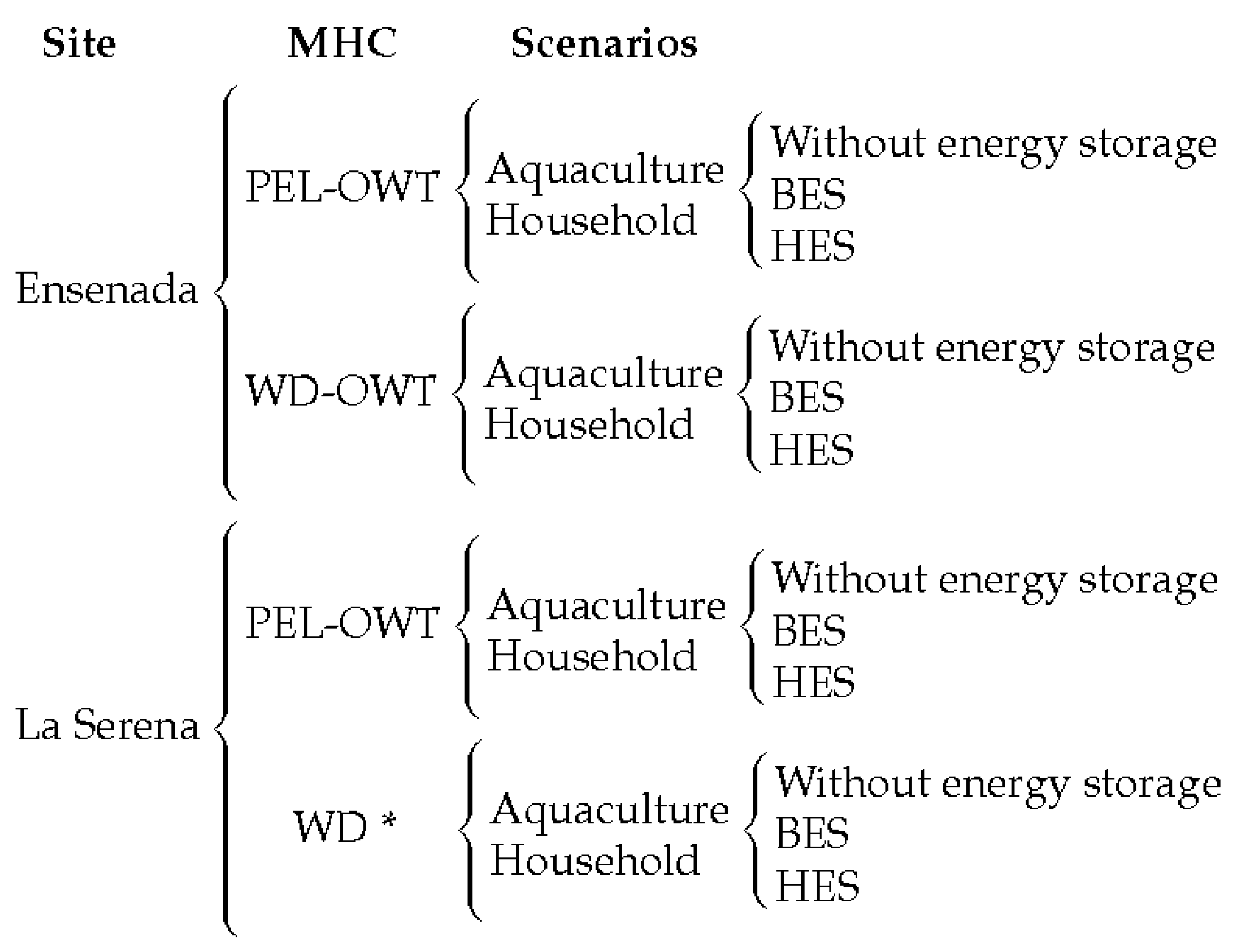
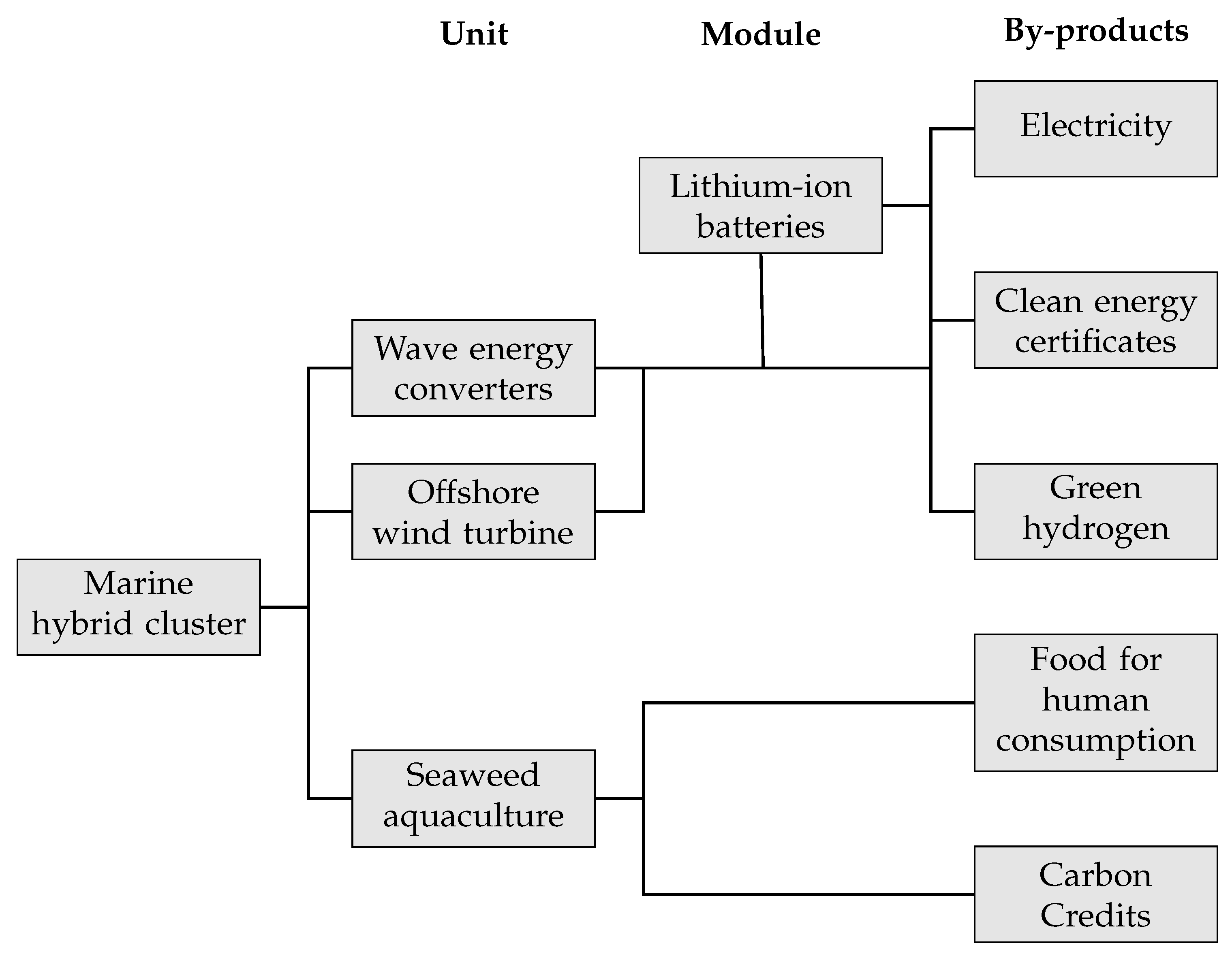
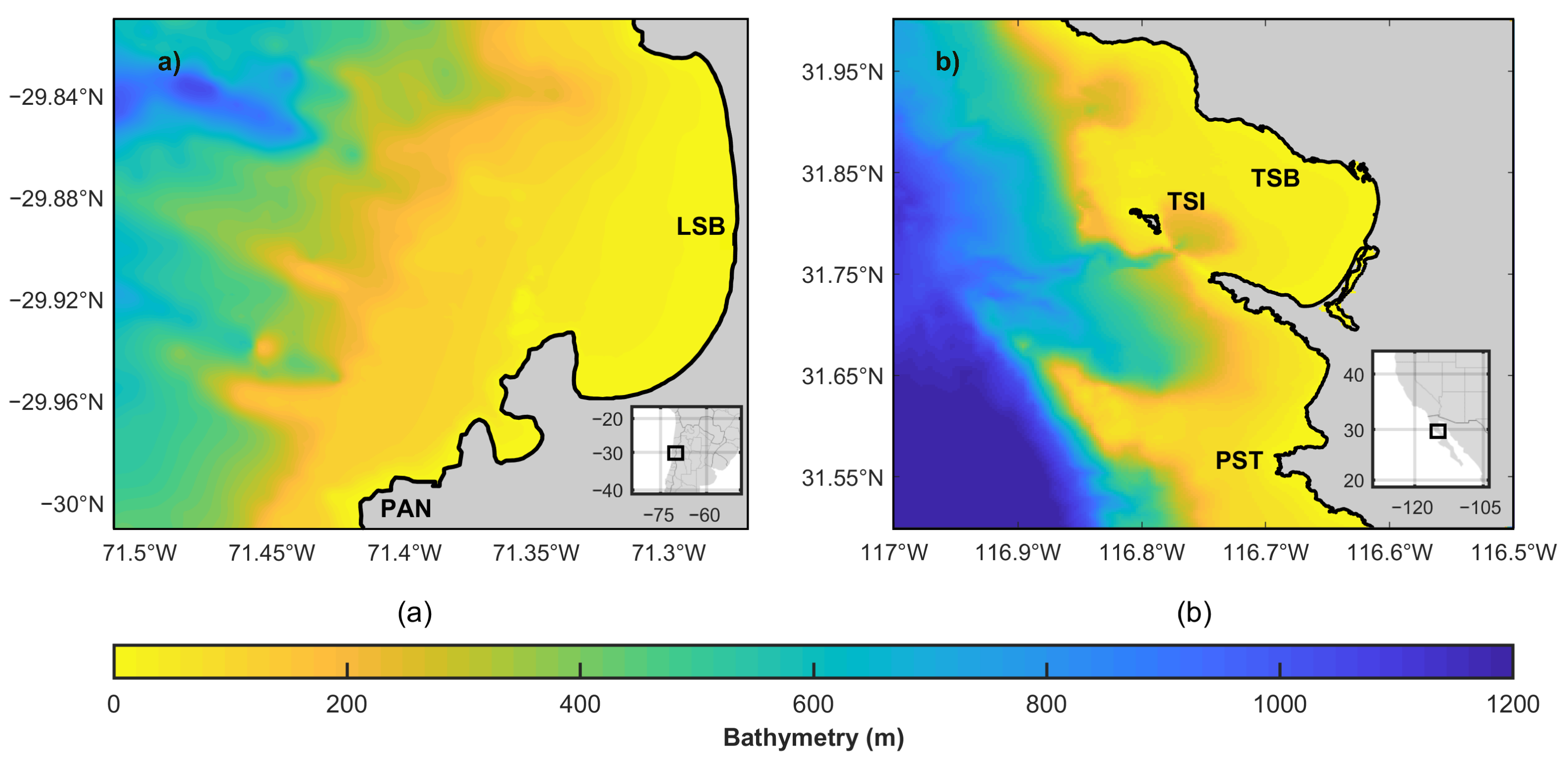
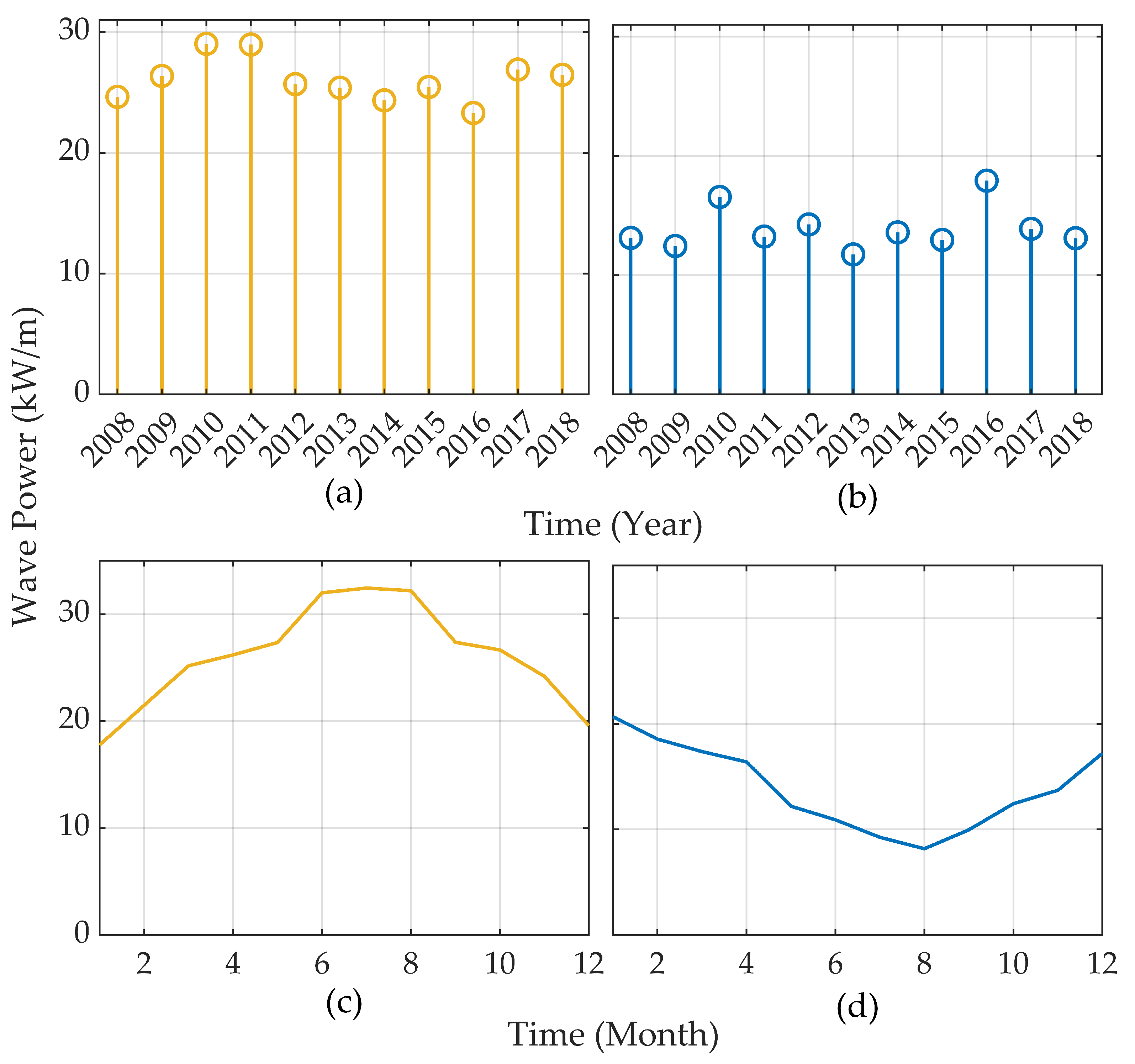
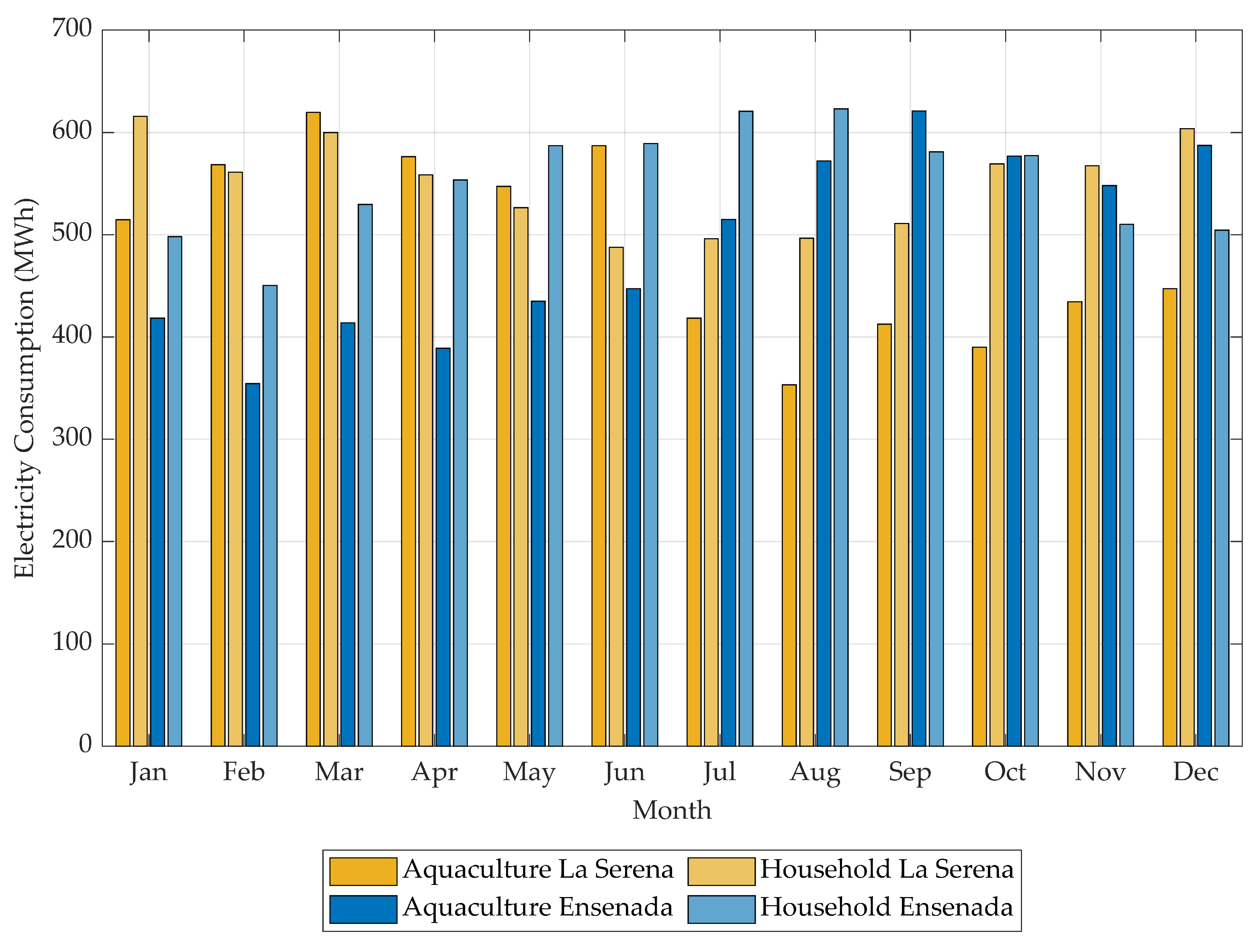
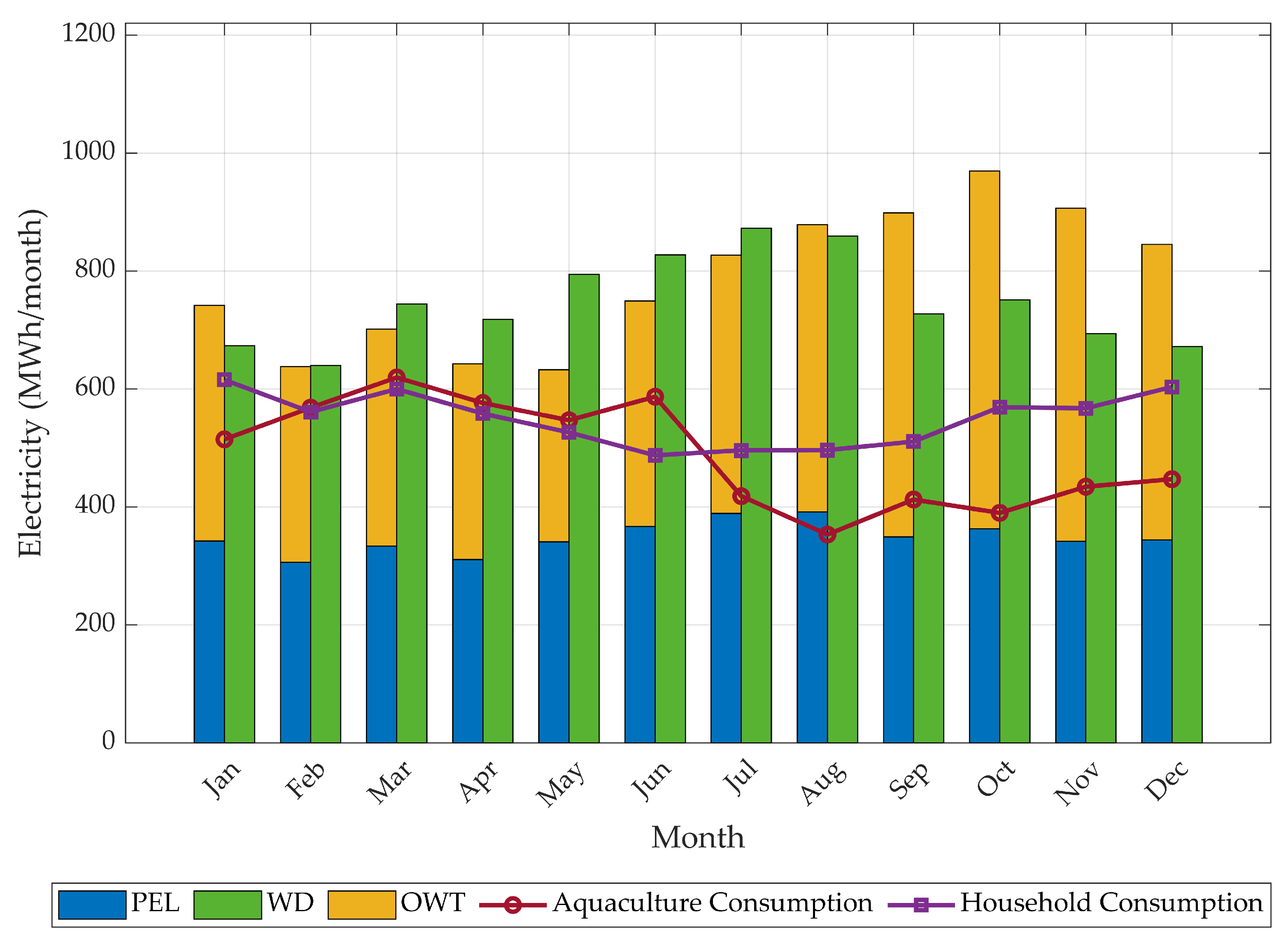
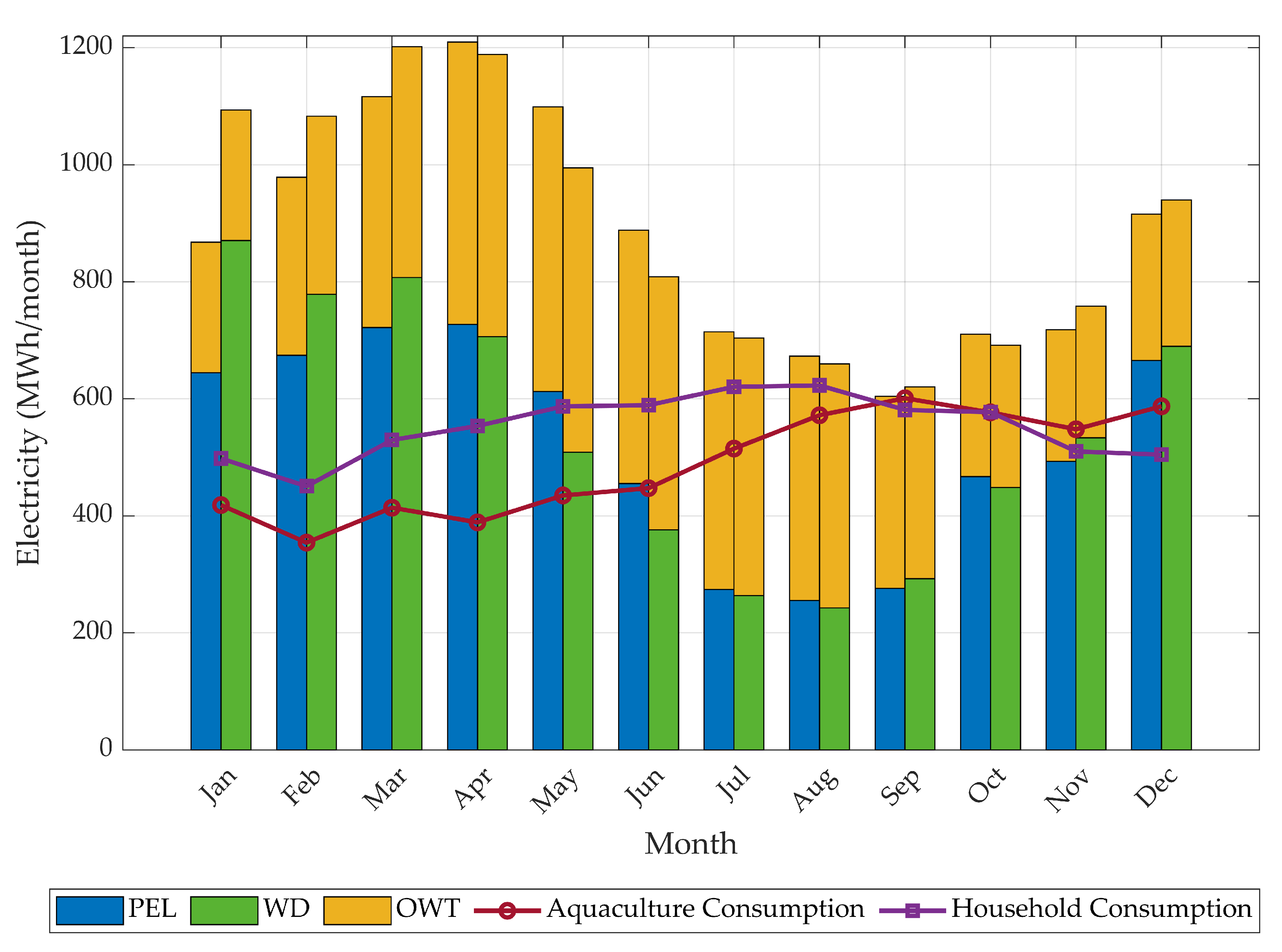
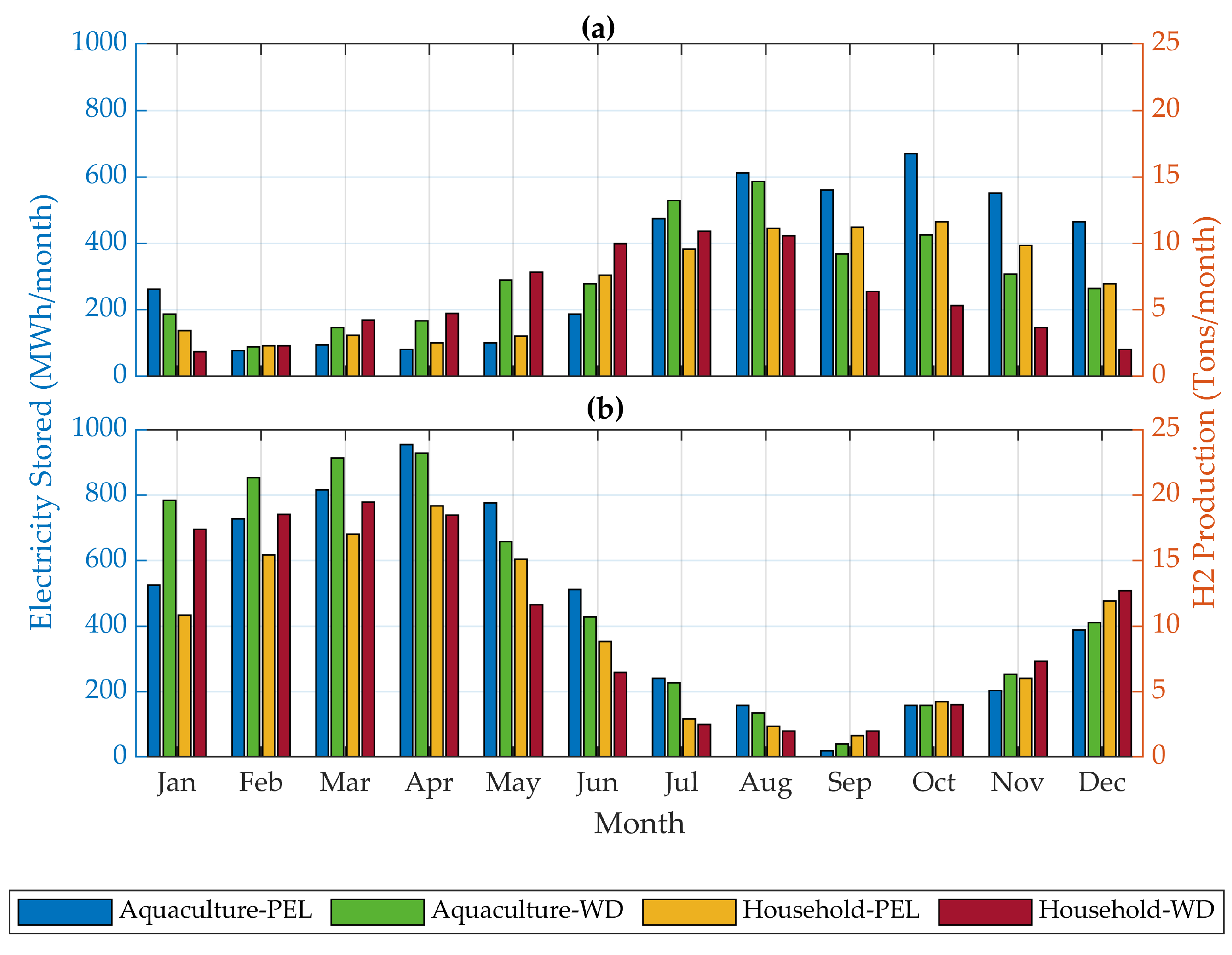
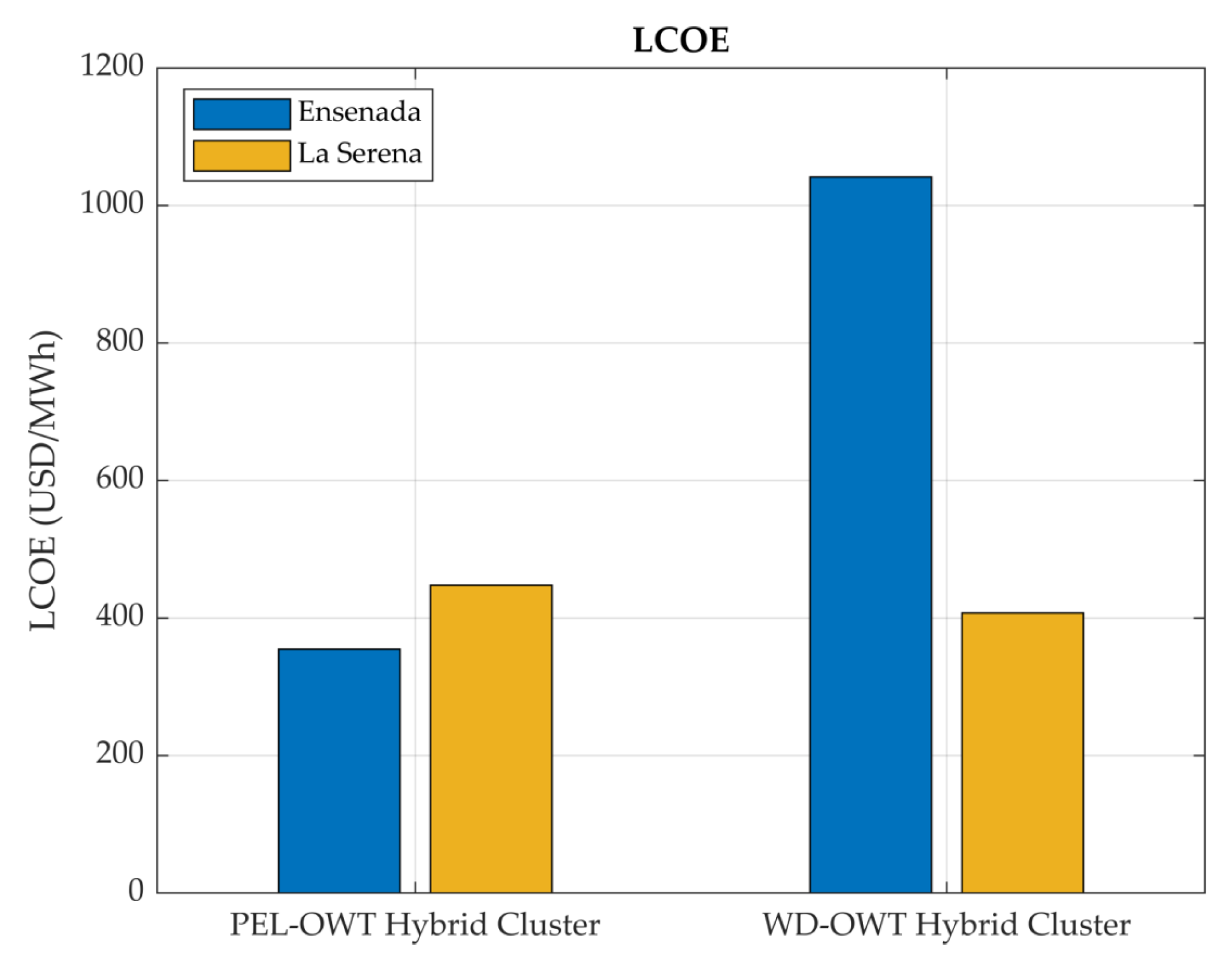
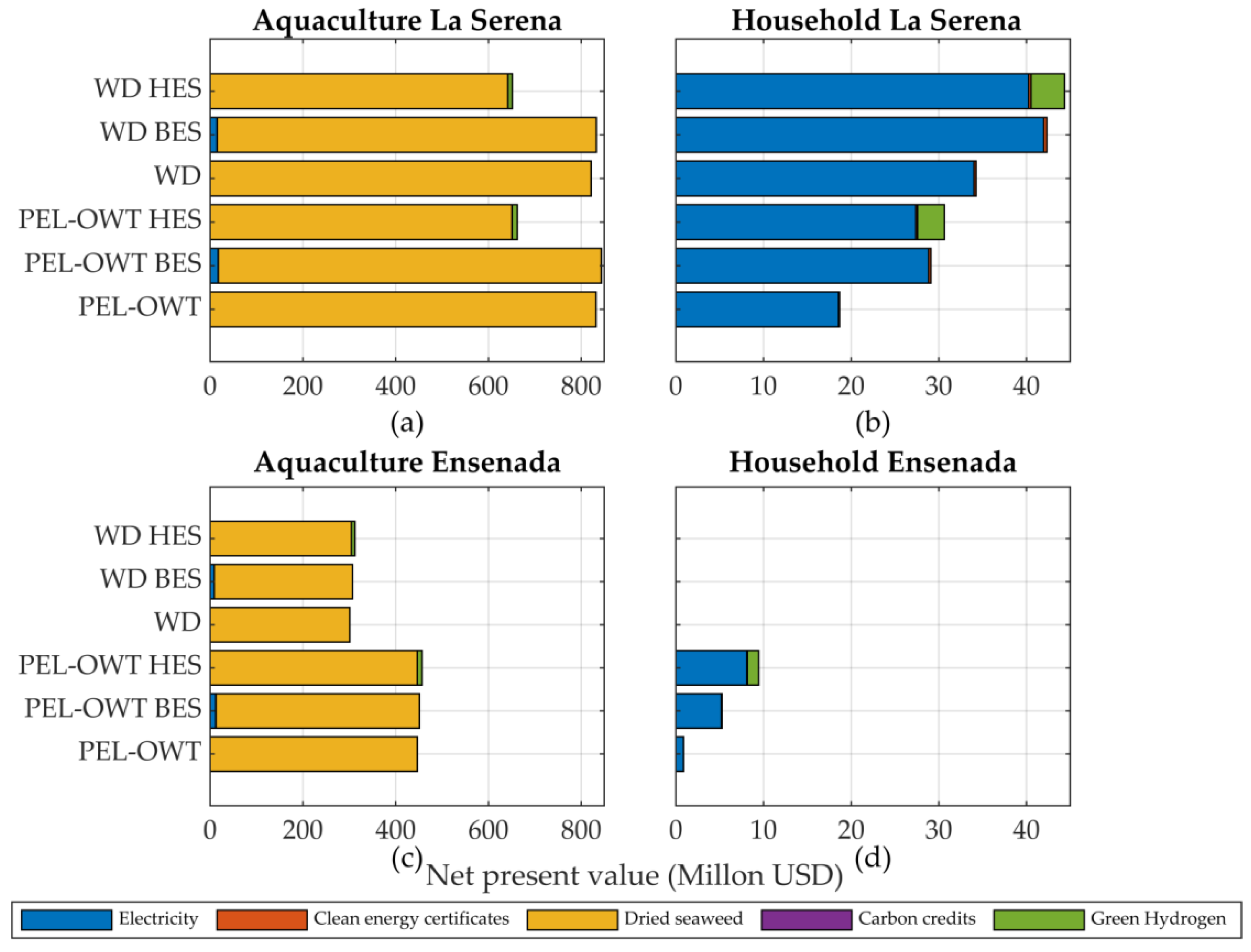

| Scenarios | Energy Consumption | Energy Generation | Hybridization | Number | Number | ||
|---|---|---|---|---|---|---|---|
| GWh/year | MWh/month (average) | GWh/year | MWh/month (average) | of WECs | of OWT | ||
| La Serena PEL-OWT Aquaculture | 5.87 | 489.06 | 9.43 | 785.98 | 44.23% | 6 | 1 |
| La Serena PEL-OWT Household | 6.59 | 549.39 | 9.43 | 785.98 | |||
| La Serena WD Aquaculture | 5.87 | 489.06 | 8.98 | 747.93 | N/A | 1 | 0 |
| La Serena WD Household | 6.59 | 549.39 | 8.98 | 747.93 | |||
| Ensenada PEL-OWT Aquaculture | 5.88 | 489.81 | 10.49 | 874.55 | 59.56% | 5 | 1 |
| Ensenada PEL-OWT Household | 6.62 | 552.03 | 10.49 | 874.55 | |||
| Ensenada WD-OWT Aquaculture | 5.88 | 489.81 | 10.74 | 895.40 | 60.48% | 3 | 1 |
| Ensenada WD-OWT Household | 6.62 | 552.03 | 10.74 | 895.40 | |||
Disclaimer/Publisher’s Note: The statements, opinions and data contained in all publications are solely those of the individual author(s) and contributor(s) and not of MDPI and/or the editor(s). MDPI and/or the editor(s) disclaim responsibility for any injury to people or property resulting from any ideas, methods, instructions or products referred to in the content. |
© 2025 by the authors. Licensee MDPI, Basel, Switzerland. This article is an open access article distributed under the terms and conditions of the Creative Commons Attribution (CC BY) license (https://creativecommons.org/licenses/by/4.0/).
Share and Cite
Gorr-Pozzi, E.; Olmedo-González, J.; Selman-Caro, D.; Corrales-González, M.; García-Nava, H.; García-Vega, F.; Odériz, I.; Giorgi, G.; González-Huerta, R.d.G.; Zertuche-González, J.A.; et al. Techno-Economic Analysis of Marine Hybrid Clusters for Use in Chile and Mexico. Energies 2025, 18, 5543. https://doi.org/10.3390/en18205543
Gorr-Pozzi E, Olmedo-González J, Selman-Caro D, Corrales-González M, García-Nava H, García-Vega F, Odériz I, Giorgi G, González-Huerta RdG, Zertuche-González JA, et al. Techno-Economic Analysis of Marine Hybrid Clusters for Use in Chile and Mexico. Energies. 2025; 18(20):5543. https://doi.org/10.3390/en18205543
Chicago/Turabian StyleGorr-Pozzi, Emiliano, Jorge Olmedo-González, Diego Selman-Caro, Manuel Corrales-González, Héctor García-Nava, Fabiola García-Vega, Itxaso Odériz, Giuseppe Giorgi, Rosa de G. González-Huerta, José A. Zertuche-González, and et al. 2025. "Techno-Economic Analysis of Marine Hybrid Clusters for Use in Chile and Mexico" Energies 18, no. 20: 5543. https://doi.org/10.3390/en18205543
APA StyleGorr-Pozzi, E., Olmedo-González, J., Selman-Caro, D., Corrales-González, M., García-Nava, H., García-Vega, F., Odériz, I., Giorgi, G., González-Huerta, R. d. G., Zertuche-González, J. A., & Silva, R. (2025). Techno-Economic Analysis of Marine Hybrid Clusters for Use in Chile and Mexico. Energies, 18(20), 5543. https://doi.org/10.3390/en18205543









